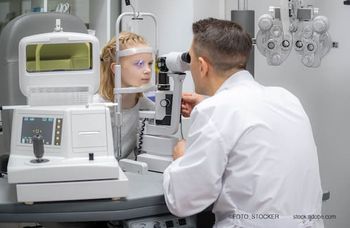
ISAK safe, predictable for reducing low amounts of corneal astigmatism
Corneal astigmatism may be reduced or nearly eliminated after intrastromal femtosecond laser astigmatic keratotomy.
Take-Home
Corneal astigmatism may be reduced or nearly eliminated after intrastromal femtosecond laser astigmatic keratotomy.
Dr. Culbertson
By Lynda Charters; Reviewed by William W. Culbertson, MD
Miami-Corneal astigmatism can be eliminated almost totally by intrastromal femtosecond laser astigmatic keratotomy (ISAK). The procedure has proven to be safe and predictable for reducing low levels of astigmatism induced after cataract surgery or naturally occurring astigmatism.
There are pros and cons for using femtosecond laser technology to create astigmatic relaxing incisions, said William W. Culbertson, MD, the Lou Higgins Professor of Ophthalmology, Bascom Palmer Eye Institute, University of Miami Miller School of Medicine, Miami.
- On the plus side, the technology can provide a precise arc length, axis placement, optic zone, and depth of treatment. Anterior penetrating relaxing incisions are titratable in position and depth; non-orthogonal astigmatism can be treated with the femtosecond laser unlike use of a toric IOL; and intrastromal incisions are possible.
- On the negative side, the laser is expensive and intrastromal incisions may interfere with LASIK procedures in the future.
One use of the femtosecond laser, ISAK, is associated with a number of advantages. It is minimally invasive, causes no discomfort, no epithelial ingrowth, has a lower infection risk, possible minimal loss of corneal sensation, and high rate of patient satisfaction.
The procedure, however, adds less surface length to the incisions (~1.25 D) compared with anterior penetrating relaxing incisions, the nomograms are not yet well established, and enhancement procedures are less straightforward, Dr. Culbertson noted.
Prospective study results
Dr. Culbertson and his colleagues conducted a prospective study of ISAK that included 15 patients treated with a femtosecond laser platform (IntraLase, Abbott Medical Optics [AMO]) who had undergone a cataract surgery and were pseudophakic with refractive astigmatism (average, 1.12 D) and a later group of 29 cases treated with the another femtosecond laser platform (Catalys Precision Laser System, AMO/OptiMedica) who had naturally occurring topographic astigmatism (average, 1.02 D) treated during cataract surgery.
The IntraLase procedure was much more labor and time intensive than the Catalys procedure. The former system’s preoperative calculations were made manually using topographic pachymetry to measure the corneal thickness for the depth of the incisions. The intended treatment axes were marked on the cornea preoperatively at the slit lamp to align the intended axis at the laser with the intended axis of the topographic treatment. With the latter system, no manual calculations are performed.
With a minimum of 3 months of follow-up, eyes treated with the IntraLase platform had a substantial reduction in the existing cylinder by 72% with slight steepening of the spherical equivalent, Dr. Culbertson said. The mean preoperative uncorrected vision was 20/50 and postoperatively 20/25.
“This result was a considerable improvement,” he said.
Results in the 29 patients treated with the Catalys platform indicated that there was a 65% reduction of the preoperative cylinder. Most of the patients had less than 0.5 D of residual cylinder. The average deviation from the intended axis was 3.6º.
This is extremely difficult to measure during a slit lamp examination, Dr. Culbertson explained. The mean postoperative uncorrected distance visual acuity was 20/25. Twenty-seven of the 29 patients had a best spectacle-corrected visual acuity of 20/20 postoperatively. One patient in this group had an increase in astigmatism from 0.63 to 1.12 D with an axis flip.
Additional applications
Other uses for this femtosecond laser technology are pairing of the limbal-relaxing incisions with the main incision and orienting the intended axis to the fiduciary mark.
Dr. Culbertson said he likes to place a small mark intrastromally when implanting a toric lens when he aligns the IOL axis along the preplaced intrastromal marks.
“ISAK is a safe and predictable technique for reducing low amounts of corneal astigmatism,” he said. “All patients in the IntraLase group, and 28 of the 29 patients in the Catalys group, did very well with reduction of astigmatism to refractively negligible levels.”
William W. Culbertson, MD
Dr. Culbertson is a consultant for OptiMedica/Abbott Medical Optics.
Newsletter
Don’t miss out—get Ophthalmology Times updates on the latest clinical advancements and expert interviews, straight to your inbox.



















































.png)


